
What Not to Burn in Your Fireplace

Recently we discussed why you should only burn seasoned wood in your fireplace or wood-burning stove.
To recap, there are two main reasons why you shouldn’t burn unseasoned or green wood in your home. First, moist wood is incredibly inefficient and doesn’t produce as much heat as seasoned wood. Secondly, unseasoned wood creates smoke, creating more creosote as it burns, which in turn sticks to your chimney. This can cause long-term issues with the fireplace’s flue.
Along with unseasoned wood, there is also a pretty substantial list of other things you should never burn in your fireplace. While some of these items might seem obvious, you might be surprised by some of the things we find in the fireplaces we service.
Manufactured wood
While it might be tempting to toss an odd piece of treated lumber or plywood in your fireplace, pressure treated wood is infused with dangerous chemicals like arsenic and chromium. Releasing those toxins into your home can cause serious side effects to both humans and animals.
Cardboard
Like pressure treated wood, cardboard is manufactured with chemicals, glues and inks. The gases that are released in the burning of cardboard can be similar to those used for huffing. Inhaling such chemicals can cause brain and respiratory damage.
Waxy paper
Many of us may head to the recycling bin when we’re looking to get a fire started. However, most paper used in advertising and magazines is manufactured with its own set of toxic chemicals. If you’re in need of kindling, save dried out twigs from your yard and use uncoated newspaper to get your fire started.
Dryer lint
Dryer lint is also a common accelerant. But just like all of the previous sources, it is filled with the chemicals that are used in the manufacture of your clothing, towels and sheets. While keeping your dryer free of lint is essential to safely drying your laundry, it has no place in your fireplace or wood-burning stove.
Christmas trees
Every Christmas many of us end up with what we may think is 6 to 10 feet of prime fireplace wood. Not so! When burned, the sap from fresh Christmas trees can cause dangerous resins to deposit in your chimney system. These resins can easily trigger a chimney fire.
Plastic
One of the very last things you’d ever want in your fireplace or wood-burning stove is plastic. Plastic is manufactured with 100 percent synthetic materials and chemicals. Burning plastic in your home is a recipe for filling your home with the most toxic of gases.
Liquid fire accelerants
Liquid fire starters like kerosene, lighter fluid or gasoline can ignite a fire that can easily get out of control in your home. Such accelerants also cause your fire to burn at a temperature that is not safe for your fireplace.
When purchasing seasoned firewood for your home, do your best to source the wood to ensure your family’s safety. Only buy from a reputable dealer and avoid online sales from places like Craigslist.
If you have more questions about what’s safe to burn in your fireplace, contact us today.
Back To Blog

